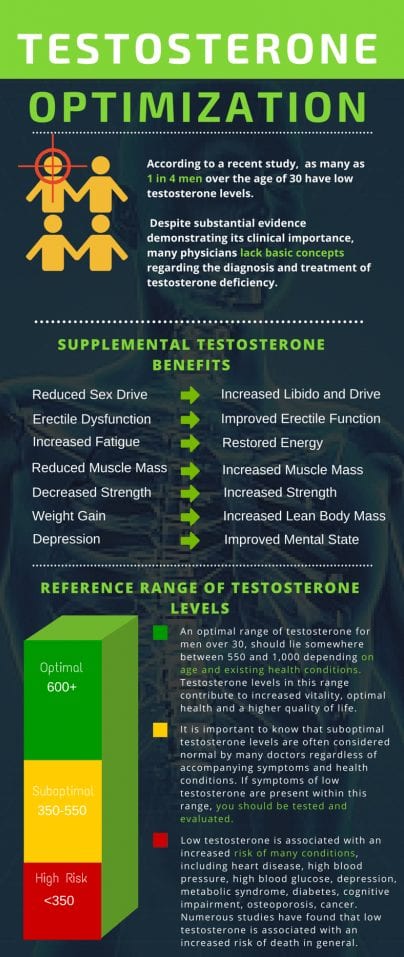What is Testosterone?
Testosterone is the principle male hormone. It appears in men in quantities up to 8 times the amount seen in women. In men, testosterone is a hormone produced mostly by the testes and is responsible for the proper development of male sexual characteristics. Optimal testosterone levels are essential for sexual activity and energy, muscle and bone mass growth, and even the prevention of osteoporosis. It promotes the primary sexual characteristics of men and is responsible for greater health, longer life and general well-being.

Do I have Low Testosterone?
A large percentage of men who have been told their testosterone is fine actually have Low T. Often the total amount of testosterone is read as adequate, but the amount of usable or “free” testosterone is low. Men suffering from Low T may have subtle to profound symptoms, ranging from poor motivation, anxiety, weight gain, a lost sense of well-being to profound depression, and loss of sex drive. Men with Low T cannot only enjoy an improved quality of life with male hormone replacement therapy or Testosterone Replacement Therapy but will also benefit from a significant decrease in the risk for heart disease, cancer, diabetes, and death.
The US Food and Drug Administration (FDA) estimates 4 to 5 million American men may be suffering from hormonal imbalance, but only 5% are currently treated. This translates into approximately 250,000 men being treated. This means that there are over 4,750,000 men who are untreated. If you are reading this you could be one of them.
The only accurate way to detect this condition is to measure the amount of testosterone in your blood. Many men suffer needlessly because their hormone levels are either never checked, they are in the “range”, or the wrong test is ordered. Men as young as 25 to 30 years in age are presenting hormone levels associated with andropause, which was not the case 10 or 20 years ago. This can be the result of environmental toxins, plastics, pesticides, pollutants and/or xenoestrogens in the environment.
Low Testosterone Replacement Therapy
By undergoing hormone replacement therapy, or HRT, you can increase your testosterone levels and correct the other aspects of your health as you reach an age of maturity. This will reduce your risk of Alzheimer’s, osteoporosis and prostate cancer while simultaneously giving you a renewed vigor in life. Within a matter of weeks from the start of therapy, men experience heightened sexual activity, greater and faster brain responsiveness, reduced fat, a healthier heart, and an overall renewed body.
We offer the following procedures and treatments:
Topical Testosterone Creams
The use of creams and gels are very common, requiring daily application once or twice a day. We can also have testosterone cream compounded to a specific dose for a particular patient. The upside to using a topical cream is that there is no injection. However, there are a few important concerns when it comes to using topical hormone creams.
Topical testosterone cream sounds quick and easy, but there are some important concerns which we have to take into account prior to prescribing. Topical testosterone cream can be transferred through the clothes for up to 12 hours after application. What does this mean for patients? We do not recommend topical to men with small children because they can transfer it to the kids. Once it is transferred to the kids they will start developing masculinization symptoms.
Not only does testosterone transfer occur up to 12 hours after application, if you are not careful with your hygiene after application will also inadvertently transfer it to others as well. For instance, let’s say you apply your cream a with your right hand and then you use that hand to open the faucet, you will leave some residual testosterone cream on the tap and some who comes along and opens that faucet later will inadvertently absorb the hormone.
Men who are married or involved in a relationship should really consider not using topical testosterone because it can be transferred during intimacy.
On another note, testosterone applied on the skin is quickly converted to DHT because most of the enzymes which convert testosterone to DHT is located in the skin. While on testosterone replacement therapy the DHT levels will be monitored on a regular basis.
Testosterone Injections
Interestingly, many men who seek hormone replacement therapy prefer injectable therapy. For those who are interested in doing self-injections, our office will schedule a training session in order to teach you how to perform self-injections safely. This session takes about 10-15 minutes. Treatment by injection is often a better option; a shot of testosterone is usually performed 1-2 times a week based on the dose. The downside is the hassle of self-injection and the pain associated with the shot. In addition to the pain associated with the injection, there may be some pain from the actual testosterone but is rare.
Injectable testosterone is in an oil base and can produce some muscle soreness after injections. The oil base allows for the hormone to be time released for 7-10 days. With hormone injections, the injection sites can be rotated between injections. There is also the potential to develop a skin infection at the injections site, which is why we do an injection training session. This is extremely rare if you follow the injection technique as taught.
Many men prefer this option. It is the most popular and it is a good option for men who are married, involved in a relationship, have small kids or single.

"Testosterone levels make the difference between running on empty or running on all cylinders!"
Testosterone Myths
Between two and four million men in the US alone suffer from below-normal testosterone levels, a condition known as hypogonadism.
It’s a problem that gets progressively more common as men age, though it can also strike men at any age for a variety of reasons. Unfortunately, very few men with below-normal testosterone are getting the help they need. It’s estimated that only 5% of the millions of men with hypogonadism are currently being treated, despite a booming business in testosterone replacement therapies of many kinds.
This surge in the use of testosterone products may not be an entirely good thing. Testosterone replacement therapy is only appropriate and safe for men who have below-normal levels and who don’t have any medical conditions that could be made worse by testosterone, such as an enlarged prostate or evidence of prostate cancer.
As we will see, use of testosterone by men with normal levels is very risky. The symptoms of hypogonadism are often overlooked, because, in part, they are mistaken for ordinary signs of aging.
Men with below-normal testosterone experience the following:
- Low interest in sex
- Tiredness
- Muscle weakness
- Small or soft testicles
- Erectile dysfunction
- Weight gain, particularly around the waist
- Reduced bone density
- Depression
- Anemia
The enormous industry that has sprung up to capitalize on this problem has contributed to a dangerous rise in the unregulated sale and use of testosterone supplements. Far too many men are obtaining quick-and-dirty prescriptions for testosterone, and abusing the hormone because it makes them feel temporarily younger and stronger.
Myths and understandings about testosterone abound. Here are the ones we hear most often:
1. Testosterone improves fertility.
False. Testosterone, particularly at the levels commonly used by athletes for performance enhancement, can effectively sterilize a man and cause his testicles to shrink and become soft.
2. Being overweight has nothing to do with testosterone levels.
Wrong. Extra fat on the body acts like a sponge, taking testosterone out of the blood and reducing libido, energy, and other male-related characteristics. This is particularly true if the fat is carried around the belly or abdomen. Fat carried on the thighs or buttocks has less testosterone-draining effects.
3. Men can raise their testosterone levels by exercising vigorously.
The relationship between testosterone and exercise is complicated. Yes, moderate exercise can raise testosterone levels somewhat, but if exercise is extreme, testosterone levels can actually drop. It’s also true that low testosterone makes it harder to exercise, which can lead to a vicious cycle of inactivity and reduced hormone levels.
4. Male mid-life crises have nothing to do with testosterone.
Many times when men say they are bored with their careers, their wives, or their general lot in life, they are actually suffering from low testosterone. This is typically referred to as “Mid-life Crisis”, when guys think buying a hot new car will give them a shot of sex appeal or attractiveness, when in fact, they would be much better off getting their testosterone level checked.
5. Testosterone supplements are safe because they have to be approved by the FDA.
Wrong. In fact, as of this writing, the government does not regulate the sale or use of products containing compounds that get converted into testosterone. Testosterone or testosterone precursors should only be used under a doctor’s supervision and testosterone levels should only be raised to normal levels.
6. Low testosterone causes depression.
True, but that’s just half the story. Most men don’t know that depression, or depressed mood, can lower their testosterone levels. Since many men don’t recognize signs of their own depression or are reluctant to seek help treating depression, this is a significant problem for millions of men. Sometimes restoring testosterone levels can also alleviate symptoms of depression – and sometimes alleviating the depression with psychotherapy and/or antidepressant medications can raise testosterone levels.
7. Erection-enhancing medications, such as Viagra, work whether a man has normal testosterone levels or not.
Studies show that erection-enhancing medications work best in men with testosterone levels in the optimal range. Testosterone provides the necessary urge to have sex that erection-enhancing drugs cannot provide.
8. Testosterone therapy is really just a form of cosmetic pharmacology – it’s just something middle-aged men try to make themselves feel young.
Wrong. Testosterone replacement for men of any age who have below-normal levels is a valid medical treatment for a condition with clear potential to degrade overall health and well-being. Failure to treat hypogonadism puts men at higher risk for frailty, osteoporosis, heart disease and, perhaps, Alzheimer’s disease.
9. Low testosterone is only a problem for old men.
False. Certainly the older you are, the more likely you are to have low testosterone, but this condition can affect any man, even teenagers. Conditions such as varicoceles, undescended testicles, and certain genetic problems can cause below-normal testosterone levels which need to be diagnosed and corrected as quickly as possible.
10. The only way to boost testosterone levels is with shots.
Wrong. Several options are now available for testosterone replacement therapy, some of which work by coaxing the body to increase testosterone levels naturally rather than by dumping testosterone directly into the bloodstream one way or the other.
Being Smart About Testosterone
Testosterone clearly plays a major role in men’s health and fertility, but achieving healthy levels must be done the right way. As with anything, knowledge is power, and to reap the benefits of testosterone therapy you must learn a little about what testosterone is, how it works, and what can cause levels to sink below normal.
Low testosterone (hypogonadism) can be caused by many factors, all of which play out against the normal steady decline in testosterone levels with age. Tumors on the pituitary gland, which controls testosterone production in the testicles, problems with the testicles themselves, injury, infections, and being overweight can all cause testosterone levels to drop below normal. Excess body fat does this because testosterone is normally broken down in the body’s fat cells. If you have a lot of fat, your body breaks down testosterone quickly, leading to a deficiency. As mentioned above, abdominal or “belly” fat has a greater capacity to convert testosterone to estrogen than other types of fat.
Another risk factor for hypogonadism that has only recently come to light is diabetes. A strong relationship has been discovered between impaired glucose tolerance, which is a cardinal feature of diabetes, and low testosterone levels. It appears that the high blood sugar levels and/or low insulin levels characteristic of diabetes harm the cells in the testicles that are responsible for making testosterone. A very recent study of 221 middle-aged men confirmed this finding: The men most likely to be diabetic also had the lowest testosterone levels.

